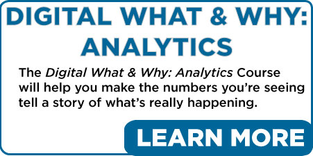 My three-year-old grandson led me to a meaningful epiphany recently. We were sitting at the kitchen table playing with some Play-Doh when he watched me sink my thumb into a small ball of the clay. He pointed to my thumbprint and asked, “What’s that?”
My three-year-old grandson led me to a meaningful epiphany recently. We were sitting at the kitchen table playing with some Play-Doh when he watched me sink my thumb into a small ball of the clay. He pointed to my thumbprint and asked, “What’s that?”
I answered, “That’s an impression.”
Like most three-year-olds will do, he followed my answer with a question: “Why?”
“Because when I touched the Play-Doh, I left a mark on it.”
He proceeded to copycat the procedure, pressing his fingers and handprints into several lumps of clay; after each masterpiece, he would attempt to form the new word he had learned: “Look, Grandpa, I made a ‘preshun’.”
“I left a mark on it.”
I had been to a marketing conference earlier in the week, where much of the focus was on falling CPMs, and rightfully so. Once upon a time, the cost of access to consumers was high, thanks to the relative scarcity of media. There were only one or two newspapers in most major metropolitan areas, and only a couple dozen radio and television stations (even fewer in smaller markets, of course). The law of supply and demand favored companies who distributed advertising messages, where the supply of big audiences was (comparatively) limited, and the demand was high.
Today, those dynamics have changed. The morning paper many folks read is rarely made of paper; instead, many read the version that is delivered via tablet. And in addition to “the local” paper, a consumer might scan a half-dozen other news sources before the day even begins. In addition to traditional terrestrial television and radio, we have cable and satellite options, streaming content, and time-shifted programming. To the typical marketer, audiences are everywhere, no longer the domain of a select few media companies, but now they are neither as large nor as scarce as they once were. As a result, what used to cost a lot of money—audiences—are now a dime a dozen.
Or less.
Not Even Close to “A Dime a Dozen”
 According to a report published by Monetize Pros, the cost per thousand for delivery of digital video ads is now roughly $3.00. That means reaching a dozen people doesn’t cost a dime; it costs .036 cents or less than half a penny. Digital display ads cost even less at a CPM of $2.80, or .0336 cents per dozen people reached. In 2015, audiences are not a dime a dozen. They’re worth much less than that. But the reality is that an enormous number of these “impressions” are not impressions at all… but merely exposures.
According to a report published by Monetize Pros, the cost per thousand for delivery of digital video ads is now roughly $3.00. That means reaching a dozen people doesn’t cost a dime; it costs .036 cents or less than half a penny. Digital display ads cost even less at a CPM of $2.80, or .0336 cents per dozen people reached. In 2015, audiences are not a dime a dozen. They’re worth much less than that. But the reality is that an enormous number of these “impressions” are not impressions at all… but merely exposures.
Now, we could talk all day about click fraud, bots, or poor digital ad placement (many digital ad exposures will never even been seen). But I’m not going to go there. I’d like to focus on all of the advertising messages that may indeed be seen or heard, but still don’t matter. Just because an audience is exposed to a message does not mean the message will leave an impression.
See also: 7 Basics to Selling Digital Advertising Creative
The term banner ad blindness has been in vogue over the past few years, but the problem to which it refers has been around forever. Long before the digital age, there were plenty of television, radio, or newspaper ads whose premise was so weak or copy so poor that the messages were utterly ignorable. (Many of these were brought to you by companies that, understandably, no longer exist.) The only difference was the intrusive nature of advertising; a media company had the power to suspend programming—place it on hold—and position an advertising message between you and the content you wanted. If you wanted the program, you had to sit through the commercial to get it… and even that was no guarantee that consumers would pay it any mind because people took the opportunity to raid the fridge or hit the head.
So this truism is nothing new: An advertising message must earn the attention and interest of its audience before a response or engagement can be achieved.
Like any relationship, capturing the interest and attention of a desired audience comes from knowing who they are, what they like, and what their priorities are. So how well do you know the audience you deliver? How well do you know the target consumers your advertiser is trying to reach? When you think about those consumers, do you have a clear understanding of why people buy the product or service being sold? What problem does it solve? What true needs will be satisfied through this purchase? What personal perceptions will be gratified, or what kind of experiences will be enhanced when the consumer acts on your advertiser’s offer? Where else could the consumer go to make this purchase or satisfy these needs? And how does the advertiser stand out in comparison to those alternatives; what is their competitive advantage or unique selling proposition?
Once you have taken the time to know your target audience this well, you can go beyond just “reaching” it to actually touching it. Leaving your mark. Making an impression.
Stop and think about how important that is. Go back to the CPM issue, and realize that it costs as little as three cents to reach a dozen people with a message. That means the barrier to entry for bombarding audiences with messages is very low… which in turn means that lots of companies are in a position to carpet-bomb the media landscape with lots and lots of messages. Look: Many people already feel like the quantity of advertising they’re hit with has gotten way out of hand… and more advertising is not going to make that situation better. No wonder we have all learned to filter the information we’re bombarded with and pay so little attention to so much noise. (And that’s just using our power to ignore, not counting such defensive tools as pop-up ad and spam blockers, DVR ad skipping, etc.)
Against that backdrop, it is even more important that your message connects quickly, that it is thoughtful, considerate, and compelling. Consumers are getting good at turning a blind eye and a deaf ear to any message that fails to appeal and fails to resonate quickly with their needs and priorities. That is why the difference between simply buying an exposure and making an impression has become even more pronounced.
- The next time you plan a campaign (whether you are buying it or selling it), don’t just focus on the cost-per-thousand of the people a message will be exposed to.
- In addition to how many people will be reached (quantitative), consider what kind of people will be reached (qualitative).
- Think about who the target consumers are, and why those people buy.
- Note the programming or content that is likely to surround your message, and therefore, the context with which your target audience is likely to consider it.
- Reflect on every aspect of the creative: the aesthetics and color, the background elements (whether graphic or audible), and foreground copy. Should your approach be entertaining humor or helpful information? Should you employ common-sense logic or heartfelt emotion?
- When the consumer is exposed to this message, what do you want them to think? How do you want them to feel? What do you want them to do? Does your copy and its delivery elicit these reactions?
These questions can lead you to the consistent creation of superior advertising messages, and serve as a litmus test by which any message or campaign could—and should—be judged.
After all, while we live in a time when there is an abundance of ways to distribute messages cheaply, the art of creating high quality messages seems to be, strangely, rare. If that is something you are truly good at and a skill set you continually work to improve on, you are creating a remarkable advantage for yourself and your organization.
After all, you must touch something to leave an impression.
Even a three-year-old knows that.



